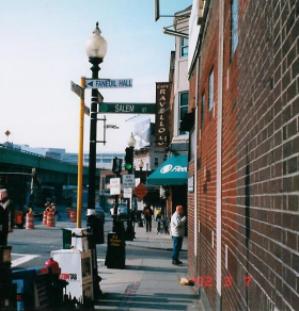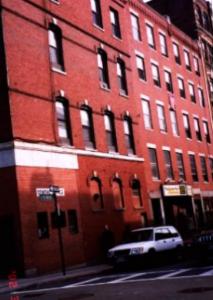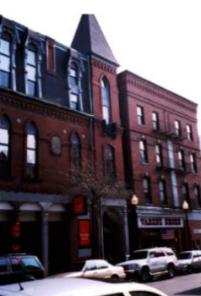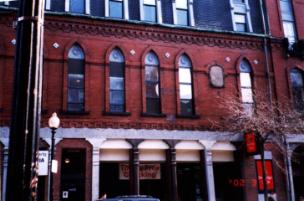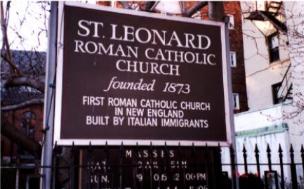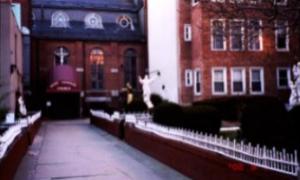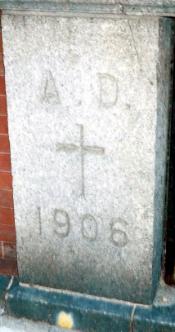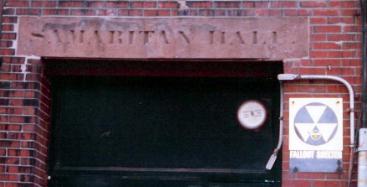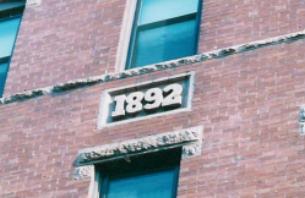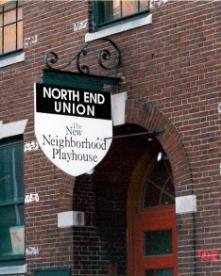In the North End, as in nearly any neighborhood in Boston, there are traces of the past. Sometimes they jump right out at you, as in the case of an historical building with a plaque describing its historical significance. Other times, you have to know what you are looking for in order to find evidence that the area holds special historical value. There are instances of both obvious and subtle traces of history in the North End, a neighborhood rich in history.
Central Artery
As can be expected, the Central Artery has left many traces in the North End. Beyond the effect the Artery has had on the street layout, discussed in Assignment 2, it has also left some more subtle traces. Many buildings that would have been in the path of the Central Artery were knocked down; this can be seen in the buildings that face Cross Street. These buildings have few, if any, windows in the side that faces Cross Street. Had these originally been built as end buildings, the side that faces the street would most likely have had more windows, a door, and other decorative features. As can be seen in the picture however, this is not the case. It is likely that when buildings were knocked down for the Central Artery, the remaining buildings were patched and left to stand alone. And though Cross Street has existed since the late 1700s, it was moved closer to Salem and Hanover Streets during construction of the Central Artery, necessitating the removal of buildings.
From this picture, you can see that none of the buildings facing Cross St. and the Central Artery have prominent windows. These buildings were most likely not originally end buildings, but became such after the Artery was built.
Churches
Churches were a common theme in many of the maps from the 1700s, shown in many locations throughout the North End. Religion was a large part of life at that time and many "meeting houses" are listed in the 1728 map. They are an important part of the history of the North End; it is, after all, the Old North Church that Paul Revere hung the "one if by land, two if by sea" lamps when the British were coming. There is only one church located in the blocks that I am looking at, but it occupies about a half a block, making it an important presence, especially to residents of the North End.The Mystery Church on Hanover and Richmond Streets
My first thoughts when I saw this church so prominently displayed in the 1728 map was that it has been knocked down long before our time. The only churches I could recall in the North End were the Old North Church and St. Leonard's Church. Walking up the side of Hanover Street that the church had been located on, I figured I would be approaching the church head on. When I got to the corner however, I found a very un-church-like apartment building with dental office on the ground floor.The building that I first thought was a church, but wasn't. I wasn't surprised that this was the case, as I couldn't recall any church there. But when I was walking around the block again a little later, in the opposite direction and down the opposite side of the street, I noticed something interesting. What looked like a steeple or bell tower was sticking up over the rooftops of the other buildings. The windows also looked church-like, with arched tops about twice as tall as regular windows. These seemed a little elaborate for an apartment building, since this isn't exactly the rich part of town. The top level of the building looked like it had been added after the rest of the building; I could visualize a sloped roof instead of the additional floor of apartments. Plus, this was on the other corner of Hanover and Richmond Streets, which I had walked by earlier in the day. I may be stretching some of the ideas, but this explanation satisfied me.
The building with the steeple on the roof. Large, arched windows set this building apart from others on Hanover Street.
St. Leonard Roman Catholic Church
The sign on Hanover Street describing St. Leonard's Church.
This church, the most prominent one in the North End after the Old North Church, was founded in 1873. As the sign says, this was the first Roman Catholic church in New England founded by Italian immigrants. This indicates there was a large enough population of Italians in the North End at this time to support the construction and development of a religious community in the North End. The yard of the church also houses the St. Leonard's Peace Garden, the only green space in the area that I have been observing.
St. Leonard's Peace Garden off of Hanover Street. An engraving at the foot of one of St.Leonard's Parish buildings, indicating this parish center was built in 1906.
Fallout Shelter
A more recent artifact is next to the basement entrance to Samaritan Hall, part of St. Leonard's Church complex. There is a large sign next to the entrance stating that it is a fallout shelter. This is most likely from the 1950s, with the rising fear of nuclear war. It is an interesting reminder of our country's recent history.
The fallout Shelter located in the basement of Samaritan Hall, part of St.Leonard's Parish, a reminder of our recent history.
Schools and Libraries
On the 1930s map, there are three public schools on one of the blocks that I am examining. None of them are there now, but I thought perhaps that the North End Branch of the Public Library was housed in an old school building. I went in and asked, and after talking to the librarian for a while and looking at some old photographs, I think I have pieced the story together.
In 1848 and 1867, two schools were built on Parmenter Street. The Hancock School, built first, was on the corner of Salem and Parmenter, while the Cushman School, on the old property of a famous actress' family estate, was on Hanover and Parmenter Streets. These buildings were closed in 1946 and 1940, respectively, and subsequently demolished to make room for apartment buildings. The library was built on part of the site of the old Cushman School, but was a new building in 1950.
Playgrounds
In my search for the origins of the library, I found out some additional interesting facts about playgrounds in the North End. It turns out that the site of the first playground in the United States was on Parmenter Street in the North End. In 1885, as the result of a Boston doctor's observation of sand gardens in Berlin, a large sand pile was placed in the yard of the Children's Mission on Parmenter Street. It was a supervised play area that was supposed to promote the good health of children. These sand gardens, or playgrounds, as they later came to be called, spread throughout Boston and the U.S.; in 1899, 21 such playgrounds were open throughout Boston. Today, the library straddles both the old Cushman School property and the old sand gardens.
More recently, a new play area with a basketball court was installed in the middle of the block between Parmenter and N. Bennett Streets, behind St. Leonard's Church. It appears to be located where a small street once cut through the block.
Buildings
Though the North End has been densely settled since the 1700s, many of the larger, four and five story buildings have been built in the past hundred years. The buildings that I saw with markings indicating their age were built in the 1890s and 1900s. These buildings are indicative of most of the buildings along Salem Street, which is more residential and consists of mainly walk-up apartment buildings.A building on Salem St. with the date it was built, 1892, engraved on its face.
Another particularly interesting building on Salem Street was the Salem Street Station for the "Edison Electric Illuminating Company," built in 1909. This is a unique piece of the history of electricity in the city that has been preserved after all these years. It's not clear what this building is now used for, however.
North End Union
The North End Union/ New Neighborhood Playhouse is located on Parmenter Street, running between Salem and Hanover Streets. Right now the Union is under construction and it's impossible to tell if it's being turned into or from a playhouse. At any rate, the North End Union is something that my grandmother and her sister remember fondly. They talk about it as a gathering place for residents, functioning as a community center would. The Union also used to put out a community cookbook, a copy of which is still floating around in my family. It's too bad that this building on longer serves as a community center, but for older residents, it still brings back fond memories.
The North End Union/New Neighborhood Playhouse. The building is currently under construction.
The North End's rich history, spanning three centuries, helps make it such an interesting destination. It's Revolutionary period history provided many of the neighborhood's historical buildings, such as the many churches and help explain its appeal as a tourist destination. This older history blends with its more recent history as an Italian enclave. The flavor that the North End now has was directly a result of the influx of Italian immigrants at the turn of the century and can be seen in many of the buildings and churches throughout the North End. The North End is as it is today because of the influences of all of its previous occupants, who all left their mark on the neighborhood.
home
